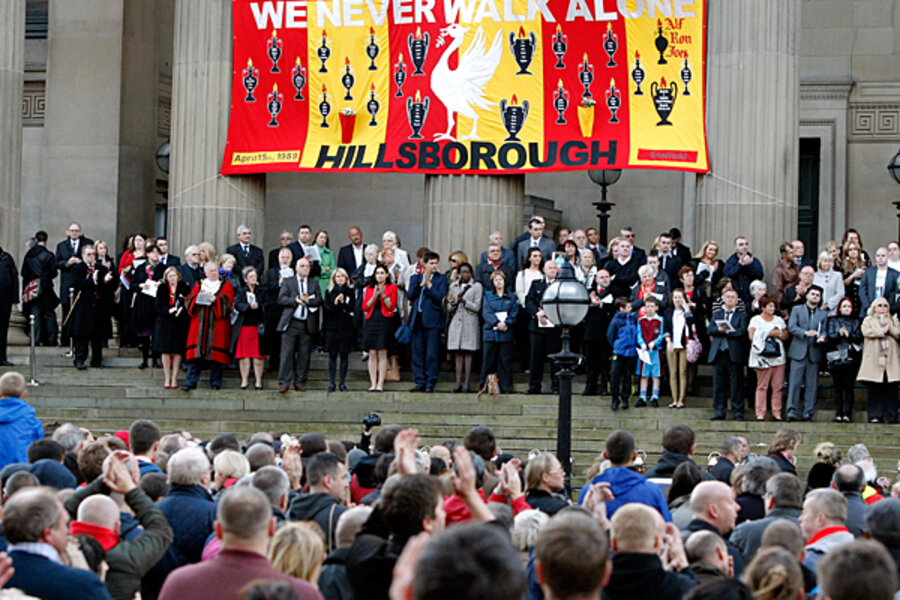Good Reads: Hillsborough, rural Russians, and chasing dreams of spaceflight
Loading...
Few events resonate in the British sporting consciousness like the Hillsborough disaster at Hillsborough Stadium in Sheffield, England, on Apr. 15, 1989. Thousands of fans of the visiting Liverpool soccer club filled the overcrowded stands – little more than cages in that era – in such numbers that they were crushed against the 10-foot-tall metal fences, killing 96 people and injuring hundreds more.
The official line had always been that rioting fans were to blame for causing the crush – much to the frustration of the victims’ families. But last Wednesday [9/12], after a three-year investigation of the disaster, the Hillsborough Independent Panel announced that the disaster was the result of a “failure in police control.” Moreover, the police had been involved in a massive cover-up to hide that fact, altering more than 116 police statements and telling a local news outlet that ticketless, drunk, violent fans were running rampant at the stadium.
The level of anguish over Hillsborough – and the catharsis provided by the new report – may be hard to grasp for those unfamiliar with it. But The Daily Mirror’s Brian Reade, who was at the stadium that day, provides a wrenching, easily understandable account of the disaster. He traces both the events of the day – the growing crush, the dawning realization of what was happening, the doomed efforts of rescuers – and the following years, as victims’ families sought justice in the aftermath. His account lets newcomers easily understand why the disaster has such resonance.
Putin losing touch with the heartland
In the aftermath of Vladimir Putin’s disputed election to a third presidential term last December, Russian urbanites took to the streets to protest in numbers unimaginable just a few years ago. But despite the high profile of the protests, it has generally been assumed that Mr. Putin’s rural constituents, who make up the vast majority of the country’s population, stand solidly behind him.
That assumption appears to be wrong. According to new data from the Moscow-based Center for Strategic Research, which surveyed people across the country, rural Russians are bucking the stereotype of “politically apathetic conformist” and may in fact be potential allies for Russia’s urban activists.
“Yes, Russians outside Moscow and St. Petersburg have no appetite for the noisy street politics and abstract slogans of their big-city counterparts,” writes Foreign Affairs. “But they are far from content with the current political system, which they see as hopelessly corrupt and inept at providing basic services. Their support for Putin grows thinner by the month, and a major economic crisis could quite easily provoke them into protests on a massive scale.“
“Although the concerns and cultures of Russia's metropolises and its provinces differ, there is no contradiction between the urban activists' dreams of greater freedom and democracy and mainstream Russians' desires for honest police officers and well-run health clinics. Indeed, a more accountable state would almost certainly be a more effective one.”
Not quite the shuttle, but close enough
While NASA is still capable of incredible feats – witness the recent landing of the Curiosity rover on Mars – it lost a certain je ne sais quoi when it retired the Space Shuttle from service last year. Satellites, rovers, and telescopes are great, but they lack the romance of manned flights in a spaceplane.
Fortunately, there is a potential love interest for shuttle-philes: Dream Chaser.
One of three vehicles being developed by NASA’s commercial space-transportation program CCiCap, Sierra Nevada Corporation’s Dream Chaser looks like a snub-winged, wedge-shaped version of the Shuttle, and is meant to fill a similar role as a reusable, small-crew spaceplane able to land at ordinary airports.
Better yet, it has a history that reads like fiction. Sci/tech website Ars Technica writes that “The Dream Chaser is a Cold War product, replete with secret military programs, spy planes, rocket scientists, Russian trawlers, and Air Force test pilots working in the middle of the desert.”
“For 50 years, three clever and highly dedicated groups of dreamers have fed, nurtured, evangelized, refined, and defended the ideas behind the Dream Chaser as it inches toward becoming a reusable! orbital! mini-spaceplane! Those words are heavenly manna for true believers, the dreamers within the space industry and the would-be vacuum visitors in every country. The Dream Chaser has survived so many false starts, and has made so much progress, that the unthinkable now looks almost likely: the Dream Chaser will soon travel all the way to orbit.”






